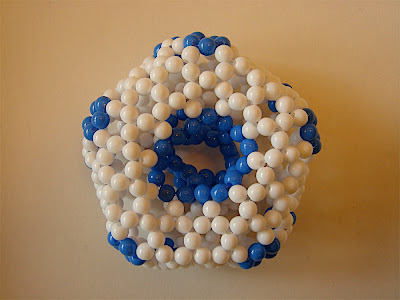http://thebeadedmolecules.blogspot.com/2006/12/strongly-distorted-tori.html
Based on these experiences, I originally thought that I5 and II5 are both unstable. Now Chuang's simple force field suggests that they are stable. Maybe this is because the inner-rim of I5 is small. I made a beaded model for I5 tonight as shown in the following picture.

We can see from this picture, the distorion in the inner-rim is quite significant, which is different from the computer-optimized geometry. Apparently, this is due to the mismatch of beads in the outer-rim. Although the distortion of I5 can be considered as small if we compare its geometry with the physical models I made a few months ago, I still tend to elimininate these twisted isomers from the list of stable isomers. Hence, there should be only 15 important isomers, instead of 19 isomers for the T240. Or only 12 isomers if we only count two mirror images of a pair of chiral compouds as one compound.
Surprisingly, this number is exactly the same as the prediction I made last December,
http://thebeadedmolecules.blogspot.com/2006/12/ten-isomers-of-t240.html,
where I suggested that there should be 12 isomers, although I only made 10 of them. Of course, there are some differences. It is obvious now there are only two isomers for D5h symmetry. But, I thought there should be 3 isomers at that time. The completely new isomer of T240 is the only one belonging to the type IV system: molecular innertube, which, I guess, couldn't find without Chuang's newly developed generalized classification scheme of toroidal carbon nanotubes.
No comments:
Post a Comment